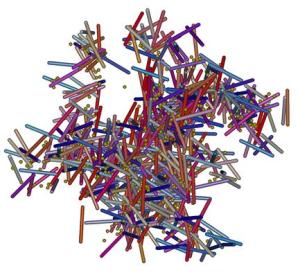A University of Luxembourg research team has created a technique that will enhance polymeric composite electrical conductivity.
 UniLu’s Percolating Network of Rods and Spheres
UniLu’s Percolating Network of Rods and Spheres
These composites contain multiple materials and are utilized to prevent electrostatics in aircraft. Additives are inducted into the composites in an effort to obtain specific characteristics. They are able to develop favourable electrical characteristics when carbon nanotubes are used to strengthen them. Such composites are deployed to construct flat-panel displays and solar cells more efficient.
The team collaborated with researchers from the Netherlands, to observe the electricity emitted by the carbon nanotubes within a polymer matrix. The percolation limit, the point where the composite starts conducting electricity, can be reduced if nano-quantities of conductive polymer latex are introduced. The simulations were carried out in Luxembourg, and the laboratory trials were done at Eindhoven University.
Professor Tania Schilling, who led the team at the university, said that minimal quantities of carbon nanotubes should be used. The team found that introducing a second component helped them to utilize the ensuing communication to achieve results. Minutely dispersed nanoparticles or colloidal particles in multiple sizes and shapes were mixed in the medium to form networks that spanned the entire system. This development is essential to develop composites that conduct electricity.
The research paper has appeared in the scientific journal Nature Nanotechnology. Other partners in the research included scientists at the Technische Universiteit Eindhoven and the Dutch Polymer Institute.